Click on images to enlarge
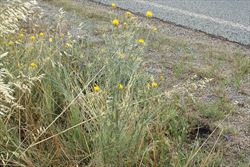
habit (Photo: Rob and Fiona Richardson)
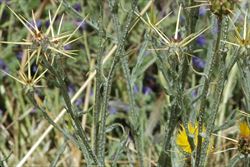
winged stems, upper leaves and young flower-heads (Photo: Rob and Fiona Richardson)
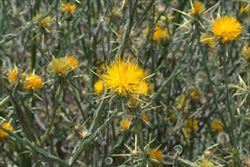
flower-heads (Photo: Rob and Fiona Richardson)
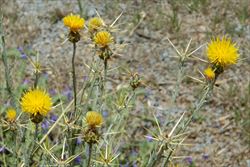
flower-heads (Photo: Rob and Fiona Richardson)
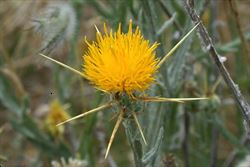
close-up of flower-head with spine-tipped bracts (Photo: Rob and Fiona Richardson)
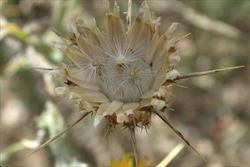
mature flower-head with seeds (Photo: Rob and Fiona Richardson)
Scientific Name
Centaurea solstitialis L.
Family
Asteraceae (Queensland, New South Wales, the ACT, Victoria, Tasmania, Western Australia and the Northern Territory)Compositae (South Australia)
Common Names
Barnaby's thistle, golden star thistle, golden star-thistle, golden starthistle, knapweed, St. Barnaby's thistle, yellow centaurea, yellow centaury, yellow cockspur, yellow star thistle, yellow star-thistle, yellow starthistle
Origin
This species is native to southern Europe (i.e. Ukraine, Albania, Bulgaria, Greece, Italy, Yugoslavia, France and Spain), northern Africa (i.e. Algeria and Tunisia) and western Asia (i.e. Iran, Iraq, Lebanon, Syria, Turkey, Armenia, Azerbaijan, Georgia, southern Russia, Tajikistan and Turkmenistan).
Naturalised Distribution
A very widely naturalised species that is found throughout the southern and eastern parts of Australia. It is most common in the sub-coastal areas of New South Wales and is scattered in northern Victoria, south-eastern South Australia and the sub-coastal regions of south-eastern and central Queensland. Less common in the southern parts of Western Australia and other parts of New South Wales, Victoria and Queensland. Also recorded in Tasmania and the ACT.
Naturalised overseas in the UK, southern Africa, New Zealand, the USA, Canada and South America.
Notes
This species was recently listed as a priority environmental weed in at least one Natural Resource Management region. Though it is mainly a weed of agricultural areas and disturbed sites, it also invades natural habitats and is listed in the Global Invasive Species Database.
St. Barnaby's thistle (Centaurea solstitialis) can form dense impenetrable stands that displace desirable vegetation in natural grasslands, rangelands, and open pastures and, due to the spiny nature of the plant, livestock and wildlife avoid grazing in heavily infested areas. These impacts can lead to a reduction in the habitat available to wildlife and decrease the native plant and animal diversity in densely infested areas.

